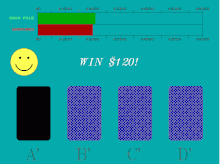This is both a guide and tutorial, so each step will relate back to an example task, the Iowa Gambling Task, which will be reviewed in the next section. Iowa Gambling Task. First, let us run through a brief overview of the task we will be using; the Iowa Gambling Task (IGT). If you are familiar with this task, you can skip to the next section. The Iowa Gambling Task The Iowa Gambling Task was, not surprisingly, developed at the University of Iowa and has penetrated somewhat into public consciousness via its discussion in Antonio Damasio's book Descartes' Error. The task involves four virtual card decks represented on a computer screen. The task enlarges the difference between positive and negative EVs to make the difference more noticeable than in the Iowa Gambling Task. While playing this game, subjects only experienced a gain or a loss during each trial, and there was no reciprocal gain-loss within individual trials.
- Iowa Gambling Task Instructions List
- Iowa Gambling Task Instructions Downloads
- Iowa Gambling Task Instructions Booklet
- Iowa Gambling Task Instructions Guide
Description
The child version of the Iowa Gambling Test™, developed by Garon and Moore (2004), is an interviewer-administered task originally given to children aged 3-6. The participant selects one card at a time from four decks. Participants are instructed that each card selected will result in winning candy, with some cards also taking candy away. The goal of the task is to accumulate as much candy as possible. Several summary scores can be calculated, including total candy won and difference between advantageous and disadvantageous selections.

For more information about the Iowa Gambling Test™, please refer to the Cognitive Atlas Interpretation.
Specific Instructions
Iowa Gambling Task Instructions List
Protocol
Summary of the Child Version of the Iowa Gambling Test™ Developed by Garon and Moore (2004)
Participants are given a starting loan of 15 pieces of candy and then instructed that the goal of the task is to win as much candy as possible by drawing cards one at a time from four separate decks. All cards reward the participant with candy, while some both give and take away candy from the participant. Two of the decks are 'disadvantageous' resulting in an equivalent net loss in the long run, while the other two decks are 'advantageous' resulting in an equivalent net gain over time.
To account for the developing mental capabilities of children instead of adults, the child version of the Iowa Gambling Test™ limits the length of the test to 40 card choices (instead of 100) and varies rewards and contingencies over five card blocks (instead of 10 card blocks). Additionally, the child version includes a four question awareness test at the end to determine whether the child knew what was occurring during the test (i.e., which decks are 'good' to choose from and why, which decks are 'bad' to choose from and why).
Scoring
Iowa Gambling Task Instructions Downloads

Significado de los palos del poker. Several summary scores can be derived, including total amount of candy won, total number of cards selected from each deck, and the total scores from the awareness portion of the test (see Garon & Moore, 2004, for more details).


For more information about the Iowa Gambling Test™, please refer to the Cognitive Atlas Interpretation.
Specific Instructions
Iowa Gambling Task Instructions List
Protocol
Summary of the Child Version of the Iowa Gambling Test™ Developed by Garon and Moore (2004)
Participants are given a starting loan of 15 pieces of candy and then instructed that the goal of the task is to win as much candy as possible by drawing cards one at a time from four separate decks. All cards reward the participant with candy, while some both give and take away candy from the participant. Two of the decks are 'disadvantageous' resulting in an equivalent net loss in the long run, while the other two decks are 'advantageous' resulting in an equivalent net gain over time.
To account for the developing mental capabilities of children instead of adults, the child version of the Iowa Gambling Test™ limits the length of the test to 40 card choices (instead of 100) and varies rewards and contingencies over five card blocks (instead of 10 card blocks). Additionally, the child version includes a four question awareness test at the end to determine whether the child knew what was occurring during the test (i.e., which decks are 'good' to choose from and why, which decks are 'bad' to choose from and why).
Scoring
Iowa Gambling Task Instructions Downloads
Significado de los palos del poker. Several summary scores can be derived, including total amount of candy won, total number of cards selected from each deck, and the total scores from the awareness portion of the test (see Garon & Moore, 2004, for more details).
Iowa Gambling Task Instructions Booklet
The Iowa Gambling Test™ is a trademark of PAR, Inc.